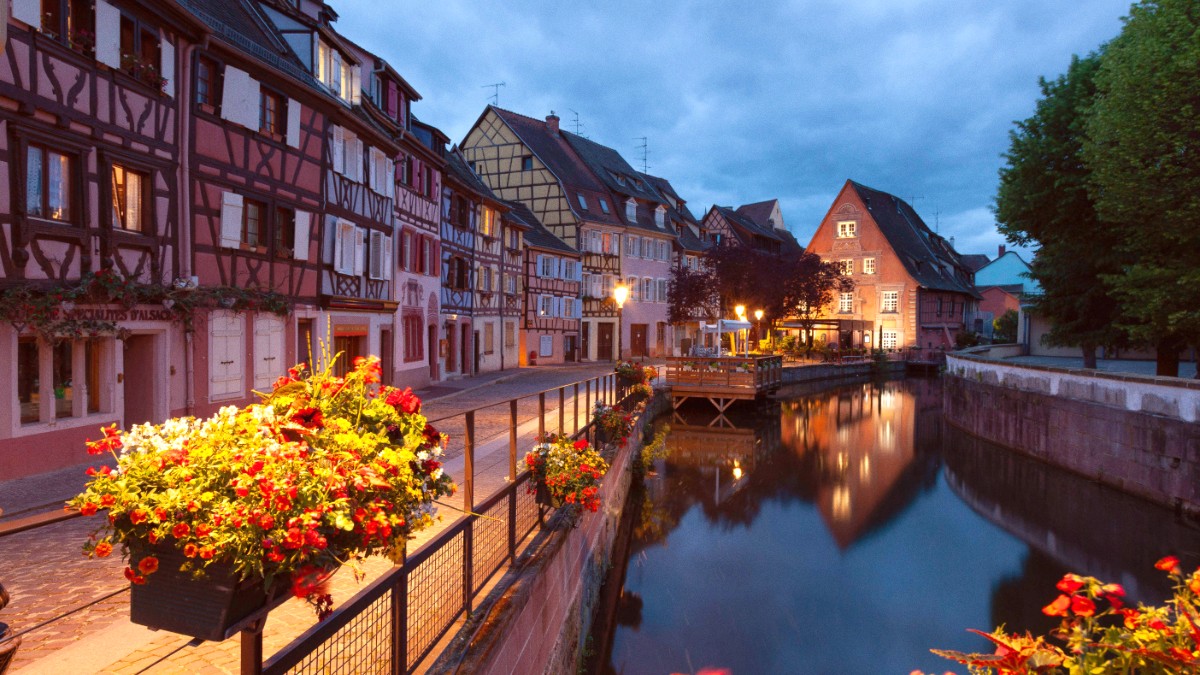
France
The city benefits from its proximity to two distinct geographical features. This natural shield also fosters the ideal conditions for the surrounding vineyards of the Alsace Wine Route, which begin just outside the city limits. To the east, the vast plain of Alsace stretches towards the Rhine River and the German border, facilitating easy connections to neighboring countries. Colmar’s terrain is largely flat within the city center, making for pleasant walking and cycling. These waterways, once for commerce, now host scenic boat tours, providing a different perspective of the charming architecture. The fertile plains around Colmar support diverse agriculture, while the Vosges foothills feature forests and opportunities for outdoor activities.
The city's roots trace back to the 9th century, with its official founding in 823. By the 13th century, it gained the status of a Free Imperial City of the Holy Roman Empire, a period of prosperity marked by extensive trade and the construction of many of the buildings still visible today. This era saw the rise of merchant guilds and the development of an unique architectural style.
The 17th century saw Colmar under French control, a shift solidified by the Treaty of Ryswick in 1697. For the next two centuries, it remained French, flourishing as a regional administrative and judicial center. However, the Franco-Prussian War in 1870-1871 saw Alsace-Lorraine, including Colmar, annexed by the newly formed German Empire. This period, lasting until the end of World War I in 1918, instilled a strong German cultural influence, evident in certain architectural elements, culinary traditions, and a persistent Alsatian dialect. After World War I, Colmar reverted to French rule, only to be re-annexed by Nazi Germany during World War II. Following its liberation in 1945, Colmar once again became part of France. This complex history of changing allegiances has shaped Colmar's identity, making it a place where French elegance meets German efficiency, and where a proud Alsatian culture thrives. The city's resilience and determination to preserve its heritage appear in its meticulously maintained historic center, a testament to its long and eventful past. This rich history frames every street, building, and tradition you encounter in Colmar.
Colmar is a medium-sized city with a population of approximately 70,000 residents, though its charm and beauty draw visitors from around the globe, making it feel larger in its tourist-heavy areas. The city moves at a slower pace than major metropolises, allowing for relaxed exploration. Its compact historic center is easily navigable on foot, providing an intimate experience of its cobbled streets, flower-decked bridges, and canals.
The local economy relies significantly on tourism, wine production (as the unofficial capital of the Alsace Wine Route), and light industry. The ambiance is one of historical preservation combined with a lively, welcoming spirit. Colmar feels like stepping into a storybook, with its iconic half-timbered houses painted in bright, cheerful colors. The "Little Venice" area, with its boat tours and waterside dining, consistently captivates visitors.
Honors the legacy of Frédéric Auguste Bartholdi, sculptor of the Statue of Liberty.
Houses the renowned Isenheim Altarpiece, a German Renaissance masterpiece.
Showcase local crafts, food, and traditions, notably the famous Christmas markets.
A blend of French elegance, German efficiency, and proud local traditions.
Often dry and sunny, making it a pleasant destination year-round.
Colmar offers a visually stunning and culturally enriching experience for every traveler. From the blooming vibrancy of spring to the festive glow of winter, each season brings its own appeal.
Approximately 70,000 residents, feeling larger due to tourist influx.
Compact historic center, easily explored on foot for an intimate experience.
The city's resilience and determination to preserve its heritage are clear in its meticulously maintained historic center, a testament to its long and eventful past.
Colmar offers distinct experiences throughout the year, with each season presenting unique advantages and considerations for visitors.
Colmar's microclimate, protected by the Vosges Mountains from western winds and rainfall, makes it one of the driest cities in France, often enjoying more sunshine than other parts of the region.
Mild temperatures, blooming flowers, fresh air. Ideal for walking in gardens.
Warm temperatures, abundant sunshine, long daylight. Perfect for outdoor dining and canal tours.
Mild, crisp air, beautiful vineyard colors. Great for hiking and outdoor activities.
Temperatures drop, snow is common. City transforms for the festive Christmas market season.
France is part of the Schengen Area; short stays up to 90 days may require a Schengen visa for non-EU/EEA/Swiss citizens.
Citizens from US, Canada, Australia, etc. Do not need a visa for stays up to 90 days for tourism/business.
From mid-2025, visa-exempt travelers will need to obtain ETIAS online before travel.
The official currency is the Euro (€). ATMs are widespread for cash. Visa and Mastercard are widely accepted. Always choose to pay in Euros when using cards.
Service charge is usually included by law. Tipping is not required but rounding up a bill or leaving a few Euros is a kind gesture for exceptional service.
Walk for transport. Eat local at markets or bakeries. Use "formule midi" for cheaper lunches. Consider a city pass for attractions. Tap water is safe to drink.